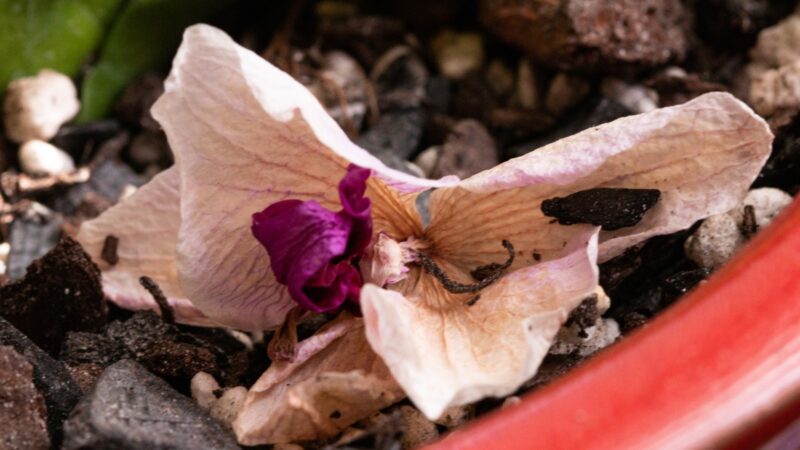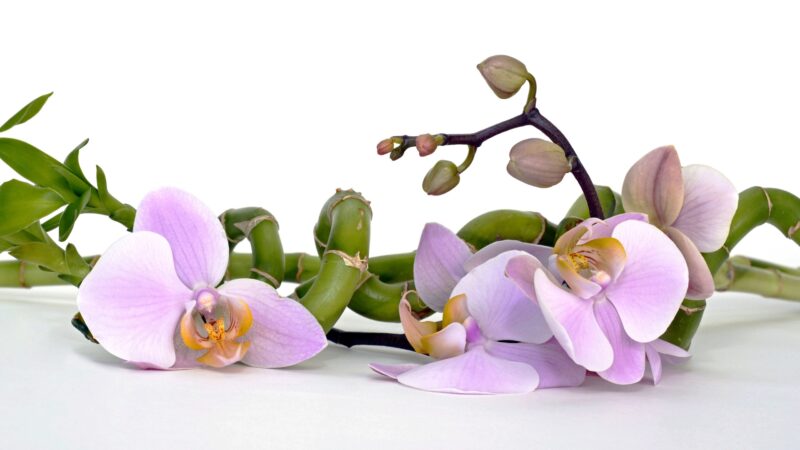There’s no denying that orchids are among the most beautiful plants out there. Aside from its head-turning cluster of flowers, orchids also come in a variety of colors.
That can truly breathe life into any garden or home. But like other plants, orchids also wilt away when not properly taken care of.
To make sure your orchids are always healthy, you have to identify the causes of a wilting orchid. The following are the causes of a wilting orchid:
- It is merely the end of its natural cycle;
- It is not getting the right amount of water it needs;
- It is due to environmental changes;
- There is a change in humidity;
- There is a change in the temperature;
- The soil quality is not ideal;
- It is due to transplant shock;
- It is infested by pests and insects.
Aside from discussing each of these causes in detail, this article will also provide you with tips and tricks to take care of a wilting orchid. And most importantly, this article will guide you to prevent another wilting episode from taking place.
Is It Possible to Revive a Wilting Orchid?

It is still possible to revive a wilting orchid. It may take a while for your orchid to return to its healthy state, but it’s not impossible. The speed of its recovery will also depend on the severity of the damage caused to the orchid.
However, to ensure recovery, you have to determine the reason why it began to wilt in the first place. As earlier discussed, there are several reasons for it to wilt, which include excessive watering, not giving enough water, using poor-quality soil, and sudden changes in its environment, to name a few.
Once you can identify the cause, it will be easy to revive your orchids accordingly.
Will Wilted Orchid Flowers Come Back?

Wilted orchid flowers may still come back. In general, orchids are known to naturally regrow their wilted parts, specifically their flowers and foliage. It is simply part of its natural life cycle.
However, it must be noted that the speed by which the wilted flowers rebloom varies depending on different orchid varieties.
Why Are My Orchid Leaves and Flowers Wilting? | 8 Causes

End of Natural Life Cycle
If you notice your orchid leaves and flowers wilting despite giving it the care and attention it needs, there’s a chance that it’s simply due to the end of its natural cycle. Plants and trees lose their leaves and flowers during a particular season, and orchids are no exception.
Depending on the orchid species, some may have their flowers bloom and leaves grow again after four days, while others may have to wait up to three months.
The orchid leaves and flowers wilt as part of their natural life cycle. But, if the plant seems to take a while to bloom again, this may be due to environmental stressors, such as in the case of a pot transfer or a dip in the temperature. These will be discussed in detail later in this article.
Watering
Like all plants, orchids rely on water to survive. It only needs as little as three ice cubes worth of water per week, so you don’t have to water it daily. However, if it does not get enough water, or if you give it too much water, it will start to wilt soon enough.
- Causes: In this case, wilting may either be due to too much water or not enough water being given.
- How to revive: The procedure to observe when reviving your orchid will depend on whether the wilting was caused by too much water or not.
In the case of overwatering your orchids, the best solution is to replant the orchid. The moisture trapped in the soil of an overwatered orchid can easily attract fungi, bacteria, or pests, and that will only make matters worse.
Thus, moving it to a pot with a new soil mix will ensure your orchid’s recovery. Also, make sure to only lightly sprinkle your orchids until it looks healthy again.
In the case of underwatering orchids, the solution is to simply give them more water. At this point, your orchids are dehydrated, so it needs a lot of water to stay healthy.
The water will also help them absorb the nutrients in the soil faster. However, once the orchid is back to its healthy state, you should switch back to giving it ideal amounts of water.
Environment Change
Orchids thrive in an environment they have grown accustomed to. That’s why you may notice them wilting once they have been transferred to a new location, especially if it’s from tree bark to a pot and vice versa.
Fortunately, this is merely temporary, and your orchid can be easily revived with tender love and care.
- Causes: The primary cause is a change in the orchid’s surrounding environment, such as when it is moved to a different house. This may also be caused when the orchid is moved to a pot with soil that’s not ideal for its growth.
- How to revive: In this case, time is your best friend. Your orchid will take some time to adjust to its new environment, so you have to be patient. But in the meantime, you can try to mimic its former environment by taking note of the temperature, lighting, and humidity levels of its previous home.
Humidity Change
As earlier discussed, orchids are tropical plants. As such, they thrive in warm areas with high humidity. In particular, their ideal humidity levels range between 40 to 65% to keep them healthy and ensure that their flowers bloom.
- Causes: The orchid is placed in an area with low humidity.
- How to revive: If you live in an area with low humidity, the best option for your outdoor orchid is clay pebbles. Clay pebbles like the CZ Organic Expanded Clay Pebbles help raise moisture levels in the area to make it more comfortable for your orchid.
- PREMIUM QUALITY INGREDIENTS: Cz Garden Clay Pebbles are high...
- ORGANIC GARDENING - Cz Garden Clay Pebbles are all natural and...
- BENEFITS: Provides excellent aeration, improves drainage, and...
- ORCHIDS: for planting or repotting a pleathora of orchids...
- HYDROPONIC HEAVEN: Cz Garden Clay Pebbles are the #1 Substrate...
Alternatively, if you prefer to have your orchids indoors, you may opt to adjust your humidifier’s settings accordingly. A good example is the Rosekm Humidifier, which is ideal if you have other indoor plants in your room.
- 𝘾𝙤𝙣𝙩𝙞𝙣𝙪𝙤𝙪𝙨 𝙈𝙞𝙨𝙩...
- 𝙋𝙚𝙧𝙛𝙚𝙘𝙩 𝙛𝙤𝙧...
- 𝘾𝙤𝙢𝙥𝙖𝙘𝙩 &...
- 𝙀𝙛𝙛𝙤𝙧𝙩𝙡𝙚𝙨𝙨...
- 𝘾𝙪𝙨𝙩𝙤𝙢𝙞𝙯𝙖𝙗𝙡𝙚 𝙈𝙞𝙨𝙩...
Temperature Change
Aside from humidity, you should also bear in mind that orchids prefer warm temperatures. Particularly, they thrive when the temperature ranges between 65 to 85°F.
If the temperature exceeds this ideal range, the orchid may become dehydrated, and its leaves and flowers will turn wrinkled. In contrast, when the temperature is too cold, the orchid’s growth may become stunted.
- Causes: The usual cause for wilting due to temperature change is if the temperature dips or exceeds 65 to 85°F.
- How to revive: There are two ways to revive an orchid that has wilted due to temperature changes.
- The first is if the cause is a drop in the temperature. This usually happens during the cold autumn and winter months. In this case, it’s best to keep your orchids indoors and set your home’s heater to the ideal temperature levels. But even then, make sure your orchids still get enough water and access to sunlight.
- The second is if the cause is excessively hot temperatures. In this case, you can revive your orchid by giving it more water and keeping it from direct sunlight. This will prevent it from further dehydration while also keeping it from being sunburned. It is also advised to keep your orchids indoors if it’s too hot outside.
Soil Quality
To ensure the growth of healthy orchids, you have to make sure that you’re using the ideal soil for it. Specifically, orchids thrive in soil that’s porous or well-draining.
If the soil is too dense, it may not support the growth of the orchid’s roots. And that, in turn, may result in stunted growth of the orchid.
And in case the orchid has been replanted into soil that’s dense and compacted, the roots will have a hard time absorbing water and nutrients. This will cause the orchid to wilt and die eventually.
- Causes: The only cause is that the soil used is not ideal for orchids. Particularly, it is too dense, compact, and retains too much water.
- How to revive: To revive a wilting orchid due to poor soil quality, the best solution is to replant it into a pot with new, porous soil. You may opt to add pebbles, peat moss, or coconut fiber or husk like the Prococo Chips-N-Fiber Premium Coconut Husk to ensure that the soil won’t retain water.
- Choose A Premium Coco Fiber Substrate for your plants and...
- Top Soil Alternative Coconut Fiber Substrate can be used as top...
- We make all of our coconut chip coco husk substrate of...
- Just add the required water and your Reptile or Growing substrate...
- The Premium Prococo Chips-N-Fiber Coconut Husk substrate is the...
Transplant Shock
As earlier discussed, orchids love familiarity. They thrive in an environment they are used to, so moving them to a place that’s completely different from their usual home will surely stress them out.
Similarly, if the orchid is carelessly transferred into a new pot, it can lead to transplant shock. This usually takes place when the roots of the orchid have been damaged during the transplant process.
- Causes: There is transplant shock when the roots are damaged by the abrupt or careless repotting or transplanting of the orchid.
- How to revive: The best way to revive a wilting orchid due to transplant shock is to add one tablespoon of Agricultural-Grade Epsom Salt, like Epsoak Epsom Salt. This will help soothe and heal the roots to make the recovery faster.
- From plants and vegetables to flowers and lawns, Epsom Salt -...
- Epsom Salt can do amazing things to help your Garden flourish....
- For soil naturally low in magnesium, applying Epsom Salt can help...
- Most commonly used to make tomatoes and peppers taste sweeter,...
Also, make sure to mimic the environment of your orchid’s previous home – paying particular attention to the temperature and humidity levels. This will help your orchid adjust faster and thereby recover faster.
Pests and Insects
Regardless of the plant species, pests and insects will always be attracted to them. This is especially true in case there is the presence of rotting matter and a moist environment.
Unfortunately, the presence of pests and insects will only speed up the plant’s deterioration, so it’s best to take immediate action.
- Causes: A pest infestation may be caused by rotting leaves or retaining moisture in the soil.
- How to revive: In the case of a severe infestation, the first step to take is to spray the orchids with insecticides to kill the pests.
A good example is the Monterey LG 6148 Neem Oil Ready-To-Use Insecticide, Miticide, & Fungicide, which uses neem oil to prevent the further spread of pests, insects, fungi, and more.
- KILLS SEVERAL FUNGAL DISEASES - Monterey fungus and insect killer...
- CONTROLS MANY INSECTS & MITES - The insect treatment spray also...
- VARIETY OF USES - This pest control can be used on Roses,...
- READY TO USE - This CSI alternative is conveniently ready to use...
- ORGANIC GARDENING - The active ingredient in our bug killer spray...
Once you have gotten rid of the insects, you should carefully separate the damaged parts from the healthy parts. Then, replant the healthy part into a new pot with new soil.
This is a precautionary step in case the old soil is breeding fungi and bacteria that can further cause damage to your wilting orchid.
Taking Care of a Wilting Orchid
- Identify the cause of the wilting. As earlier discussed in this article, there are several reasons for the wilting of orchids. Relatedly, the different ways to revive a wilting orchid depend on these reasons. Thus, if you can identify the cause, then you will be able to target your orchid’s needs. That ensures that you will be able to take care of it to ensure its revival.
- Keep it away from stressors. Orchids, like other plants, are also susceptible to stressors – and more so when it is wilting. During this recovery stage, make sure to pay close attention to your orchids and provide it with the right amount of water and sunlight it needs. Otherwise, the stressors might delay the recovery process.
- In case of severe damage, don’t hesitate to turn to fertilizers. Fertilizers provide orchids with the nutrients they need to grow and be healthy. This will also help speed up the plant’s recovery, so it’s best to feed your orchids fertilizer during the recovery period, especially if the damage is severe. To be specific, it’s best to use liquid fertilizers like The Grow Co Organic Ready to Spray Orchid Food Mist since these are easily absorbed by the roots.
- WONDERFULLY ORGANIC - Contains premium organic ingredients that...
- FOR VIBRANT, GROWTH & BLOOMS - Made urea free to gently feed your...
- READY MIXED PLANT MISTER - Already pre-mixed liquid fertilizer in...
- PERFECT PLANT CARE - Well-balanced mix of all the nutrients your...
- FOR ALL ORCHID VARIETIES - Made to use on your phalaenopsis,...
- Don’t replant the orchid more than once a year. Orchids love being familiar with their surroundings. Thus, moving them to different pots frequently can cause them stress. If you keep on moving a wilting orchid, that will only cause a delay in its recovery. Thus, make sure to keep your wilting orchid in its pot – unless the cause for its wilting requires repotting.
- Make sure to monitor your orchids to prevent an infestation while it’s still recovering. Wilting orchids have yellowing and rotting parts, which are attractive to pests and fungi. This alone is a reason to keep a close eye on your orchids. Otherwise, these can lead to an infestation that will only make your orchid’s condition worse.
Related: When to Use Orchid Food? | 10 Best Orchid Fertilizers





